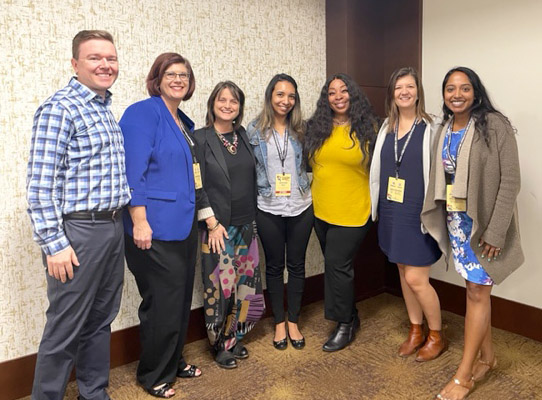Finding ways to involve and collaborate with research-practice partners is essential. In the October Pullias Center newsletter, Zoë Corwin highlighted our work on developing and studying professional learning communities (PLCs) as part of the Promoting At-promise Student Success (PASS) Project. As part of our study design, the PASS team has been committed to translating key findings into practical tools that practitioners can use in their practice.
The focus and process of developing those materials has evolved. During the first stage (2015-2020), the research team created briefs that summarized key findings with recommendations or guiding questions that practitioners could use to reflect on their practice. For example, we created a proactive advising guide that explored how to support at-promise students.
Our practitioner partners at the University of Nebraska and the Susan Thompson Buffett Foundation reviewed and gave feedback on initial drafts but were not generally involved in the writing or presenting of that work. In the second stage (2021-2026), we invited our practitioner partners to be collaborators in developing many of the practitioner-oriented materials.
We have found that their involvement in the translation of research into guidance for practice has been essential. They often have specific and practical recommendations about how other practitioners can implement the recommendations emerging from the study. In addition to the PLC syllabus and guidebook developed to support cross-functional learning related to improving at-promise student success, the practitioners collaborated with us to develop specific activities that help faculty, staff and leaders explore how to leverage the learning process to inform their practice. A few of the ideas they developed include:
- Improving Communications to At-promise Students – The tool explores how to review emails, published policies and other communications through the norms of ecological validation. The strategy was developed by practitioners who participated in the PLCs who were exploring how to integrate what they learned into their daily work.
- Considering Everyone on Campus to be an Educator – Practitioners encouraged all individuals on campus to consider how they can help educate at-promise students on being successful in college.
- Developing a Summit or Professional Development Event – After learning about how ecological validation could positively influence their work, PLC members developed professional development events for their campuses. In reflecting on the process, they shared lessons learned.
Our practitioner partners are committed to student success, and are also busy faculty, staff and administrators. We needed to develop collaborative strategies that enabled them to highlight their work without taking their time away from the important work they do to support students and colleagues on a daily basis. During initial conversations about a potential collaborative manuscript or presentation, we would begin by assessing how they wanted to navigate the process. A few of our approaches included:
- We would develop a first draft after gathering insights from observing their work or a conversation with them about the ideas. They would respond to the document and suggest edits, which we incorporated during the review process.
- The practitioner may have developed an activity or a draft of an idea, which they sent to us. We would then collaborate with them to turn it into a final brief or document that could be shared with a broader audience.
- We co-presented an idea at a practitioner conference, which led to discussions about how to turn those ideas into something more official that could be shared.
Incorporating our practitioner partners into the dissemination process became a priority for several reasons. First, we wanted to avoid taking full credit for “discovering” ideas that they had developed and been implementing on campus. Our goal was to help them elevate those ideas.
Second, the collaboration with practitioners improved the final product. They noted instances when we used academic language that would not make sense to practitioners. In addition, they provided specific examples and practical recommendations that helped to translate our more conceptual ideas into concrete suggestions for practitioners.
While not every research study can be structured in a way that leverages the involvement of the faculty, staff and administrators who participate in the study, we found the process to be extremely beneficial – especially in a long-term research-practice partnership. We appreciate the time and dedication that our practitioner-partners committed to creating resources that could support the work of other educators across the nation.








